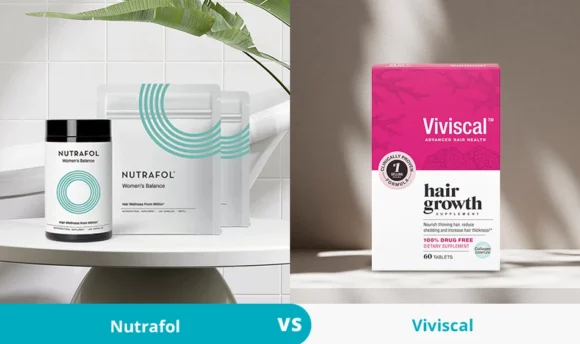How to Remove Hair Product Buildup: 6 Easy Techniques You Can Try at Home
Hair product buildup can lead to dull, lifeless hair. Explore easy steps to remove the buildup and restore your hair’s natural shine.

We all use haircare products to moisturize our strands, keep them shiny, and even improve overall scalp health. However, if you skip a shampooing session or don’t wash your hair properly, those once beneficial products can also leave a residue on your scalp, leading to buildup.
Product buildup can be detrimental to the health of your scalp and manes. It can weigh down your hair and make it brittle and dry, causing breakage and a thinning appearance. It can also clog the hair follicle, preventing hair growth and reducing natural shine.
Your regular shampoo – especially a sulfate-free one, might not remove the buildup when this occurs.
Learn how to remove hair buildup naturally, its causes, and how to identify it. Then, explore how to prevent hair buildup and achieve healthy-looking locks.
How to Remove Hair Buildup Naturally?
Styling products such as wax, gel, mousse, texturizer, and hairspray can build up in your hair and scalp. One way to remove these buildups naturally is to use baking soda and water.
When dissolved in water, baking soda can dissolve any buildup of soap, oil, or residue from common haircare products, leaving your hair sparkling clean, shiny, and soft.
If you don’t have time to make an at-home solution, add a clarifying shampoo to your regular haircare routine. A clarifying shampoo is a quick and convenient way to remove buildup from your hair and scalp.
These shampoos are specially formulated to deep cleanse your hair and remove any product residue, excess oils, or hard water minerals that can cause buildup.
What Is Hair Buildup?
Hair buildup can be divided into two types: natural buildup and product buildup. Natural buildup occurs when dead skin, dirt, and sebum naturally accumulate on the scalp over time, especially if you wait too long between shampoos.
Product buildup is the progressive accumulation of product residue on the scalp and hair. These products are cosmetic in nature and range from hair sprays to styling gels and pastes, mousse, heat protectants, shampoos, and conditioners.
Hair buildup can clog hair follicles, preventing nutrients and moisture from getting in and ultimately preventing natural hair growth. The excess buildup can also physically weigh down your hair, dry it out and increase the risk of breakage.
Various factors can cause scalp buildup, including:
- Poor hair hygiene: If you don’t wash your hair frequently or thoroughly, sweat, dead skin cells, and dirt can build up on the scalp. This may lead to oily scalp and hair, a higher risk of infection, and a bad smell.
- Product buildup: Using excessive hair styling products like gels, mousses, hairsprays, and dry shampoos can leave residues on the scalp. Infrequent washing might lead to layers of products. This can weigh down your hair and affect the condition of your scalp.
- Hard water: Hard water contains high levels of minerals like calcium and magnesium, which can leave behind deposits on the scalp and hair. This also leaves the hair dry and prone to shedding or even loss.
- Medical conditions: Medical conditions like hormonal imbalances, thyroid disorders, and autoimmune diseases can increase sebum production, resulting in scalp buildup.
- Diet: A diet lacking in essential nutrients like vitamins and minerals can affect the health of your scalp and hair, leading to buildup, flaky scalp, and other issues.
How to Know If Your Hair Has Buildup
One of the most common signs of buildup is dullness. Product buildup prevents moisture from penetrating your hair strands. As a result, any shine-enhancing products you use, such as conditioners, will sit on top of the hair instead of being absorbed into it.
Another sign of buildup is when your hair loses its natural curl pattern or doesn’t hold its original texture as effectively. The layer of product buildup is blocking your natural texture-enhancing products or styling techniques.
If your hair feels dry and breaks easily, but your scalp feels greasy, it’s a clear sign that you’re suffering from buildup. This is because there is an imbalance in your scalp. The hair strands are struggling to absorb moisture, and the scalp is trying to unclog its pores by producing more sebum. The result is a mixture of dry ends and oily roots.
Another way to tell if your hair has buildup is if it lacks volume. Adding volume and definition becomes almost impossible when your hair is covered in buildup. Dull and lifeless hair will never lift from the roots. No matter how many volumizing sprays you use, it will always look limp and flat.
How to Get Rid of Buildup in Hair: 6 At-Home Strategies That Work
Scheduling a regular deep clean solves the problem of buildup. This can be accomplished with simple at-home strategies-from clarifying shampoos to apple cider vinegar conditioners. This guide explains the best ways to eliminate this unwanted buildup and help you regain healthy-looking locks.
#1 Use a clarifying shampoo
While regular shampoos are designed to remove dirt and excess oil from your hair, clarifying shampoos contain high amounts of surfactants specifically made to remove buildup and dirt from your scalp.
You can use clarifying shampoos once a month or weekly if you use more styling products. Overusing clarifying shampoos can cause your hair to lose its vital natural oils and become dry and brittle. It can also cause your hair color to fade and your scalp to dry.
#2 Reach for apple cider vinegar
Because it’s more acidic than most traditional shampoos, apple cider vinegar (ACV) can help exfoliate dead skin cells and remove buildup from hard water and hair products like dry shampoo.
ACV also has antibacterial and antifungal qualities that can kill the bacteria that cause dandruff.
The low PH level of ACV can also help restore the natural hair pH balance, close open cuticles (the outer layer of the hair shaft), reduce hair porosity and strengthen and add shine to hair.
Mix 2 teaspoons of apple cider vinegar with 8-ounce warm water in a spray bottle. Shampoo and rinse your hair as always, then spray or pour the mixture onto your scalp and massage it. Let it soak for 5 minutes, then rinse your hair with warm water.
#3 Rinse your hair in baking soda
Baking soda can be a great scalp exfoliating agent. It’s made of sodium bicarbonate, a chemical component that naturally serves as a clarifying agent. This makes it excellent for removing sebum and oils from the scalp.
Make a baking soda paste by mixing 1 tablespoon of baking soda with 3 tablespoons of water. Apply the paste to wet hair and massage it in. Let it sit for 5–10 minutes. Rinse and dry your hair properly.
Finish with a moisturizing conditioner. Adding a few drops of essential oil like lavender provides a pleasant scent and additional benefits like stress reduction, improved hair growth, and scalp health.
#4 Apply lemon juice
Lemon juice is rich in citric acid, a natural cleansing agent that eliminates excess oil and prevents buildup on the hair and scalp. This helps promote healthy hair and scalp. It also helps nourish hair follicles to shield your scalp from free radicals.
In addition, lemon has antiseptic, antibacterial, and anti-inflammatory properties that help relieve irritation and treat dandruff.
Mix 1 tablespoon of lemon/lime juice with 2 cups of water. Apply the mixture to your head and massage it on your scalp. Let it soak for 2–3 minutes, then wash it out. Follow up with a leave-in conditioner to restore any lost moisture to your hair.
#5 Use a scalp scrub
Exfoliating your scalp can give it a more thorough cleaning, removing sweat, product buildup, dandruff, and any other residue on your scalp. A scalp scrub will also help exfoliate excess skin if you have a flaky scalp.
Apply a scalp scrub on your wet, just-shampooed hair with your fingertips and rub in a gentle, circular motion.
To remove the buildup physically, you can also massage the scalp with your fingertips while using shampoo, but be sure to use your finger pads rather than your nails. While it may feel great to scratch your scalp with your nails, this may damage the scalp’s natural barrier and result in more issues.
You may also use a brush or gloves made for exfoliating.
#6 Try micellar water
Micellar water became popular in France as an alternative to skin-damaging, abrasive Parisian water. It’s now becoming a favorite of many people with sensitive skin for its ability to cleanse and remove makeup without stripping the skin of its beneficial oils.
Micelles are tiny lipid molecules that attract dirt and oil like a magnet. They bind to pollutants while maintaining essential nutrients, leaving clean, nourished hair. They remove product buildup, impurities, sweat, and dirt with simplicity while preserving the natural oils in the hair.
Fill an applicator bottle with micellar water and apply it on your hair and scalp. Massage your scalp well, then rinse your hair. Finish up with a deep conditioner to restore moisture to your hair.
How to Prevent Hair Product Buildup
Preventing scalp buildup is the best way to treat it. Here are some preventative steps you can take if you frequently get product buildup:
- Avoid overusing products. Hair products can be excellent for maintaining the overall health of your scalp and hair and for keeping your hair in style. However, it’s easy to use too much. Use hair products sparingly, adding as little product as needed.
- Maintain a healthy haircare routine. Washing regularly can help prevent buildup on the scalp. Choose a shampoo that is appropriate for your hair type.
- Apply conditioner only to the ends. Avoid applying conditioner to the scalp. This will only cause more buildup. Instead, protect your ends with conditioner because they need the most moisture.
- Shampoo your scalp only. Avoid applying shampoo to your ends. These are the cleanest parts of your hair. Concentrate on massaging and cleaning your scalp, as this will thoroughly cleanse your hair without drying it out.
- Rinse hair thoroughly. A quick rinse is not enough. Be sure to thoroughly rinse out all product residue by gently massaging your scalp as you rinse.
FAQs
Hair buildup is caused when dead skin cells, sebum, and dirt accumulate on your scalp. Another potential cause can be haircare products that build up on the scalp.
Clarifying shampoo can be the best product to remove product buildup from hair. It’s specifically designed to remove buildup, excess oil, and other impurities from hair. Use it once a week or a few times a month to keep your hair clean and healthy.
Yes, vinegar can help remove any hairspray buildup. Mix a tablespoon of apple cider vinegar with a cup of water and use it to rinse your hair.
A Word From a Trichologist
Scalp buildup can be uncomfortable and embarrassing, especially if it is accompanied by dandruff. If you have tried to treat your buildup at home or are experiencing symptoms such as burning or itching, buildup patches, scalp redness, or large flakes, you should see a dermatologist to rule out seborrheic dermatitis or another skin condition.
A dermatologist can determine the cause of your discomfort and the best course of action.
Don’t let the situation get worse. Many scalp irritations begin with excessive buildup. Your overall scalp and hair health depends on taking care of the problem as soon as possible.
Conclusion
If your hair is greasy, dull, and breaking, it could be due to buildup. Hair buildup is a problem that can be caused by several factors, including poor hair hygiene, overuse of products, or hard water.
To remove buildup and keep your scalp and hair healthy, you can use several methods, including washing with clarifying shampoos, rinsing with apple cider vinegar, and applying baking soda paste, lemon juice, and micellar water.
It’s important to note that while these methods can be effective, it’s also important to prevent buildup by regularly shampooing your hair and scalp, avoiding excessive use of hair products, and rinsing out any product residue. By following these tips, you can maintain healthy and beautiful hair.

















































 Select your language:
Select your language: 








